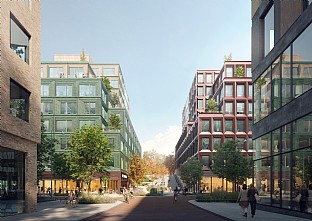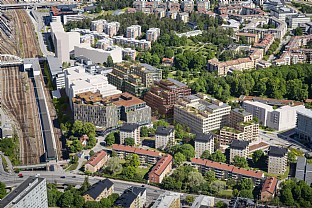Solna Station in Stockholm, Sweden is an important public transport node in the city, a hub that will be developed with the future metro and regional train station. The area, located just east of Solna station between Gårdsvägen and Kolonnvägen, is undergoing major development, including the creation of new workplaces and housing. With its central location and attractive setting, the project is an important piece of the puzzle in the development of Arenastaden.
Along Gårdsvägen, life and urbanity are created through service and retail facilities on the ground floors. The street environment is designed on cyclists' terms and will be Solna's first so-called 'bicycle street'. Traffic speed is reduced by narrowing lanes, making way for greenery and wide footpaths. The four new buildings have a varied expression in the facade through material, colour and structure. At the same time, there are recurring elements such as the tall, glazed groundfloors and terracing that let in natural light, together with generous roof terraces that shape the buildings.
The neighbourhood structure is defined by alleyways that connect Kolonnvägen and Gårdsvägen and provide space for functions such as garage entrances, waste management and emergency evacuation routes. The so-called Trapptorget (Staircase Square) is characterised by a large, generous staircase with greenery and integrated seating. The square is a place to pause and improves the movement from Solna station through the area.
Sustainable and green urban environment
In order to meet future demands for a sustainable urban environment, the zoning plan is adapted to a timber frame for all buildings. The plan's sustainability objectives are characterised by an advanced stormwater management system and ambitious rainwater reuse plans, which reduce water consumption inside the buildings. Transport to and from the site is reduced through an innovative and sustainable logistics network that coordinates deliveries and waste management. Transport is provided only by small electric vehicles, resulting in a cleaner, safer and people-centric area.






